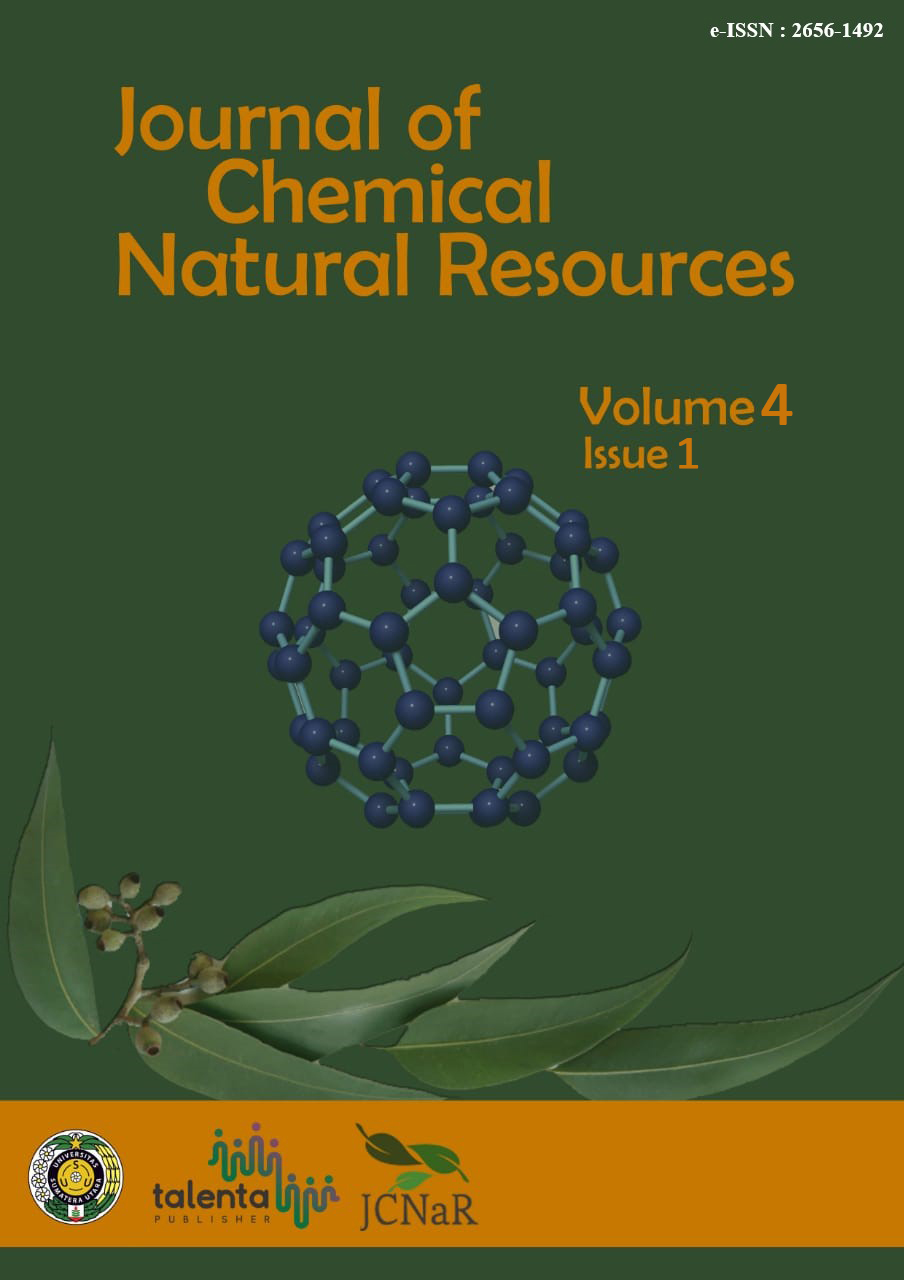Isolation and Analysis of Chemical Components of Garlic (Allium sativum L.) Tuber Essential Oil As Well As Antibacterial and Antioxidant Activity Tests
DOI:
https://doi.org/10.32734/jcnar.v4i1.9363Keywords:
Antibacterial, Antioxidant, Essential Oil, Garlic Tubers (Allium sativum L)Abstract
The essential oil from garlic tubers (Allium sativum L) was isolated by hydrodistillation method using the Stahl apparatus. Garlic tubers were distilled for 4 to 5 hours to produce as much oil as 0.05% (w/ w). The chemical components of essential oil of garlic tubers were analyzed using GC-MS spectroscopy. The GC-MS results showed that there were 11 components with 5 main components, namely diallyl disulfide (44.98%), 1,3-diallyl tri sulfane (13.63%), allyl sulfide (13.06%), methyl allyl disulfide (11.87%), and methyl allyl trisulfide (4.84%). The antibacterial activity of essential oil of garlic tubers with diffusion method to use concentration variation of 5%, 10%, and 15% have strong antibacterial activity against Gram-positive bacteria like Staphylococcus aureus and have a medium to strong antibacterial activity against Gram-negative bacteria like Escherichia coli. The antioxidant activity of the essential oil of garlic tubers with DPPH (2,2-diphenyl-1-picrylhydrazil) showed an IC50 value was 22.863 mg/L and a very strong antioxidant group.
Downloads
References
Agusta, A. 2000. Essential Oils of Indonesian Tropical Plants. ITB Publisher. Bandung
Amin S, Ruswanto, Negoro YI. 2014. Analysis of Garlic Bulbs Essential Oil (Allium sativum Linn.) Using Gas Chromatography Mass Spectrometer. Journal of Health Bakti Tunas Husada., 11: 38-39.
Hernawan UE, and Setyawan AD 2003. Review: Garlic (Allium sativum L.) Organosulfur Compounds and Their Biological Activities. Biopharmaceutical. 1:66.
Komang AS, Ni Made P and Wayan S. Chemical Content of Essential Oils From Peel of Pomelo (Citrus maxima) And Antibacterial Activity Test Against Staphylococcus aureus and Escherichia coli. Journal of Chemistry 11: 58-62.
Lawrence R, and Lawrence K. 2011. Antioxidant Activity Of Garlic Essential Oil (Allium sativum) Grown In North Indian Plains. Asia Pacific Journal of Tropical Biomedicine. 1-3:51.
Lutony, TL, and Rahmayati, Y. 2002. Production and Trade of Essential Oils. Swadya Spreader. Jakarta.
Molyneux P. 2004. The Use Of Stable Free Radical Diphenylpicryl-hydrazyl (DPPH) For Estimating Antioxidant Activity. Songklanakarin J. Sci. Technol. 26(2): 211-219.
Nasution, M., 2014. Introduction to Microbiology. USU Press. Medan.
Prihandani, SS, Poeloengan, M, Noor, SM, and Andriani. 2015. Antibacterial Power Test of Garlic (Allium sativum L.) Against Staphylococcus aureus, Escherichia coli, Salmonella typhimurium, and Pseudomonas aeruginosa bacteria in improving food safety. Agricultural Informatics. 2(1): 53-58.
Ramadhan, P. 2015. Knowing Antioxidants. Graha Ilmu. Yogyakarta.
Rohman, A. 2016. Lipids: Physical-Chemical Properties and Their Analysis. Student Library. Yogyakarta.
Sadeli, RA 2016. Antioxidant Activity Test Using DPPH Method (1,1-diphenyl-2-picrylhydrazyl) Pineapple Bromelan Extract (Ananas comosus (L.) Merr.). [Thesis]. Yogyakarta: Sanata Dharma University.
Salima, J. 2105. Antibacterial Activity of Garlic (Allium sativum l.). [Review article]. Lampung: University of Lampung.
Sanah, LA 2016. Differences in Antioxidant Activity of Garlic (Allium sativum) Heating Results (Black Garlic) Using the DPPH Method. [Scientific papers]. Malang: Indonesian Academy of Pharmacy and Food Analysts.
Sudaryani, T, and Sugiharti, E. 2005. Patchouli Cultivation and Distillation Revised Edition. Swadya Spreader. Jakarta.
Downloads
Published
Issue
Section
License
Copyright (c) 2022 Journal of Chemical Natural Resources

This work is licensed under a Creative Commons Attribution-ShareAlike 4.0 International License.















